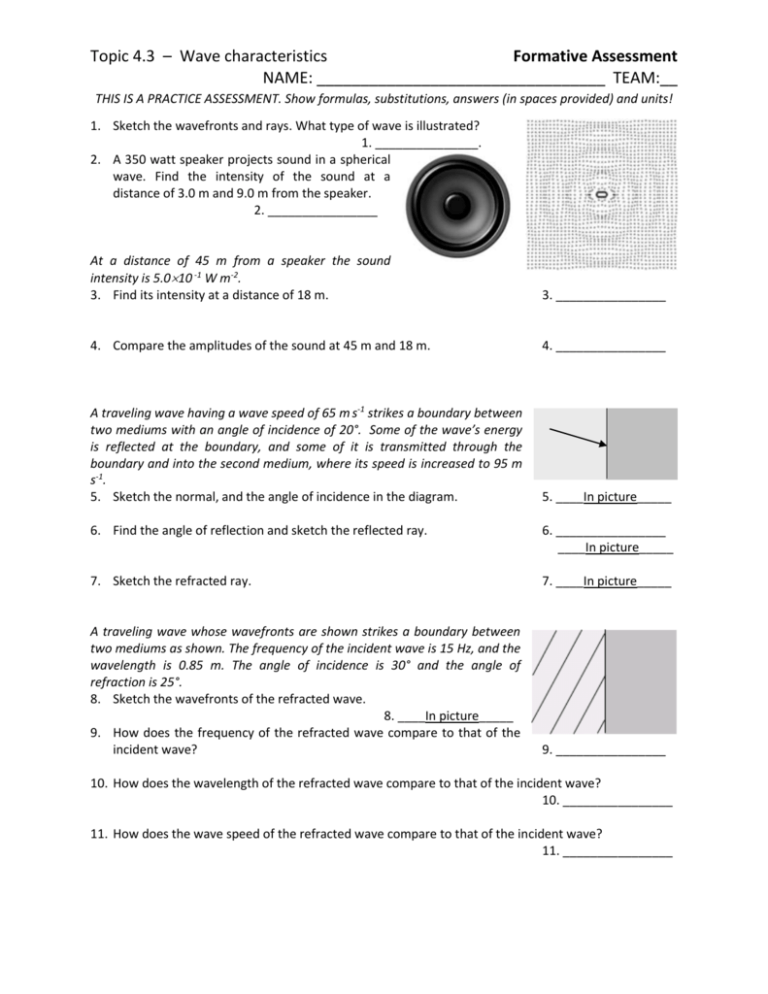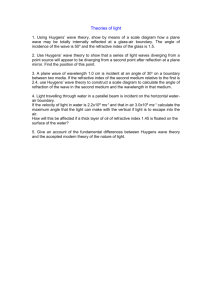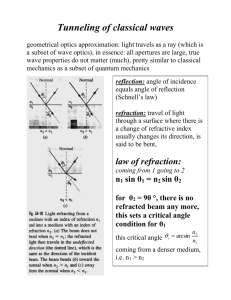Topic 4.3 Formative
advertisement

Topic 4.3 – Wave characteristics Formative Assessment NAME: _________________________________ TEAM:__ THIS IS A PRACTICE ASSESSMENT. Show formulas, substitutions, answers (in spaces provided) and units! 1. Sketch the wavefronts and rays. What type of wave is illustrated? 1. _______________. 2. A 350 watt speaker projects sound in a spherical wave. Find the intensity of the sound at a distance of 3.0 m and 9.0 m from the speaker. 2. ________________ At a distance of 45 m from a speaker the sound intensity is 5.010 -1 W m-2. 3. Find its intensity at a distance of 18 m. 3. ________________ 4. Compare the amplitudes of the sound at 45 m and 18 m. 4. ________________ A traveling wave having a wave speed of 65 m s-1 strikes a boundary between two mediums with an angle of incidence of 20°. Some of the wave’s energy is reflected at the boundary, and some of it is transmitted through the boundary and into the second medium, where its speed is increased to 95 m s-1. 5. Sketch the normal, and the angle of incidence in the diagram. 5. ____In picture_____ 6. Find the angle of reflection and sketch the reflected ray. 6. ________________ ____In picture_____ 7. Sketch the refracted ray. 7. ____In picture_____ A traveling wave whose wavefronts are shown strikes a boundary between two mediums as shown. The frequency of the incident wave is 15 Hz, and the wavelength is 0.85 m. The angle of incidence is 30° and the angle of refraction is 25°. 8. Sketch the wavefronts of the refracted wave. 8. ____In picture_____ 9. How does the frequency of the refracted wave compare to that of the incident wave? 9. ________________ 10. How does the wavelength of the refracted wave compare to that of the incident wave? 10. ________________ 11. How does the wave speed of the refracted wave compare to that of the incident wave? 11. ________________ 12. A wave pulse is approaches a fixed point in a string. Sketch in the pulse shape after reflection. 12. ____In picture_____ 13. Two wave pulses approach each other from opposite directions as shown. Sketch the waveform when the trailing edge of Pulse A and the leading edge of Pulse B are coincident. 13. ____In picture_____ The following questions are about polarization and polarized light. 14. Describe what is meant by polarized light. 15. Describe polarization by reflection. 16. Unpolarized light in air is reflected from a liquid surface in such a way that it is completely polarized. The angle of incidence is 43. What is the angle of refraction in the liquid? 16. ________________ Two disks of Polaroid are aligned so that they polarize light in the same plane. 17. Calculate the angle through which one sheet needs to be turned in order to reduce the amplitude of the observed E-field to one-fifth of its original value. 17. ________________ 18. If the initial intensity was I0, what will the new intensity be (at the angle you just calculated)? 18. ________________ 19. If we want the intensity to be one-fifth of its original value, what must be the angle through which one of the sheets is turned. 19. ________________ Polarized light of intensity I0 is incident on an analyzer. The transmission axis of the analyzer makes an angle with the direction of the electric field of the light waves entering it. 20. Explain the terms polarizer and analyzer. 21. Sketch a graph to show the variation of the intensity of the light transmitted through the analyzer as changes from 0 to 270. 21. ____In graph_____ 22. A ray of plane-polarized light of intensity 25 Wm-2 is normally incident on a polarizing filter. The intensity of the transmitted light is 20 Wm-2. Calculate the angle between the plane of the polarized light and the preferred plane of the filter. 22. ________________








